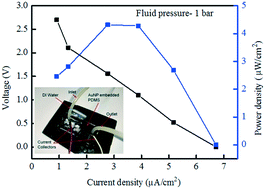Gold-nanoparticle-embedded microchannel array for enhanced power generation†
Abstract
A high streaming potential and current were generated using a gold-nanoparticle-embedded patterned PDMS microchannel array. Gold nanoparticles with dimensions of ∼70 nm were prepared inside a hydrophobic patterned PDMS microchannel. The channel array was developed on a ridge-shaped patterned surface by performing soft lithography using UV-laser micromachining with a ridge spacing of 27.0 μm, width of 22.0 μm, and height of 16.0 μm. Subsequently, tests were conducted in which ultrapure water, solutions of 0.1 M NaCl, 0.1 M HCl and 40% H2O2 were passed through the patterned channel array at various flow rates and pressures using a microfluidic pump wherein the channel inlet and outlet acted as collector electrodes. A maximum streaming potential of 2.6 V, a current of 1.3 μA, and a maximum power density of 4.3 μW cm−2 were obtained for this gold-nanoparticle-embedded PDMS channel with ultrapure water as the working fluid at an inlet pressure of 1 bar. The generated power density here was ∼256 times higher than that for the PDMS channel array without gold nanoparticles using ultrapure water as the working fluid, confirming the benefit of gold nanoparticles in the channel array, which may have potential applications in microwatt-powered lab-on-chip devices.



 Please wait while we load your content...
Please wait while we load your content...